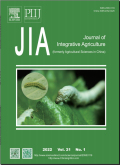首页|期刊导航|农业科学学报(英文)|Improving model performance in mapping cropland soil organic matter using time-series remote sensing data
农业科学学报(英文)2024,Vol.43Issue(8):2820-2841,22.DOI:10.1016/j.jia.2024.01.015
Improving model performance in mapping cropland soil organic matter using time-series remote sensing data
Improving model performance in mapping cropland soil organic matter using time-series remote sensing data
摘要
关键词
cropland/soil organic matter/digital soil mapping/machine learning/feature selection/model averagingKey words
cropland/soil organic matter/digital soil mapping/machine learning/feature selection/model averaging引用本文复制引用
Xianglin Zhang,Jie Xue,Songchao Chen,Zhiqing Zhuo,Zheng Wang,Xueyao Chen,Yi Xiao,Zhou Shi..Improving model performance in mapping cropland soil organic matter using time-series remote sensing data[J].农业科学学报(英文),2024,43(8):2820-2841,22.基金项目
This study was supported by the National Natural Science Foundation of China(U1901601)and the National Key Research and Development Program of China(2022YFB3903503).The authors are deeply grateful to the reviewers and the editor for their helpful comments on the manuscript. (U1901601)

